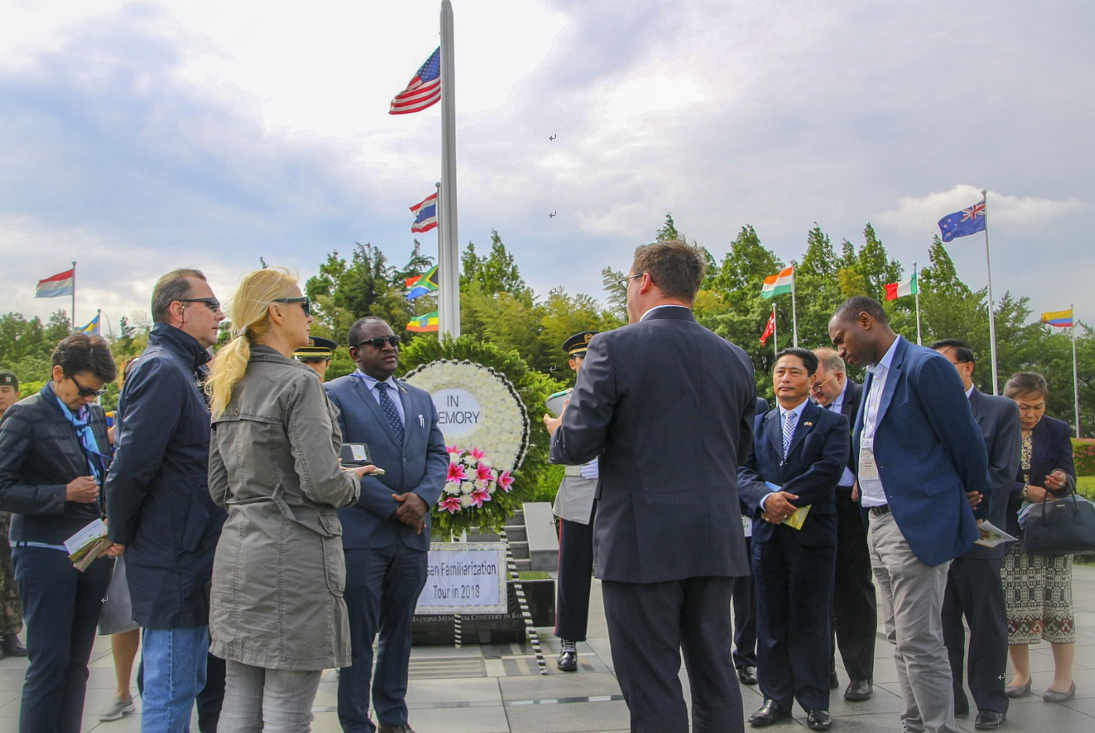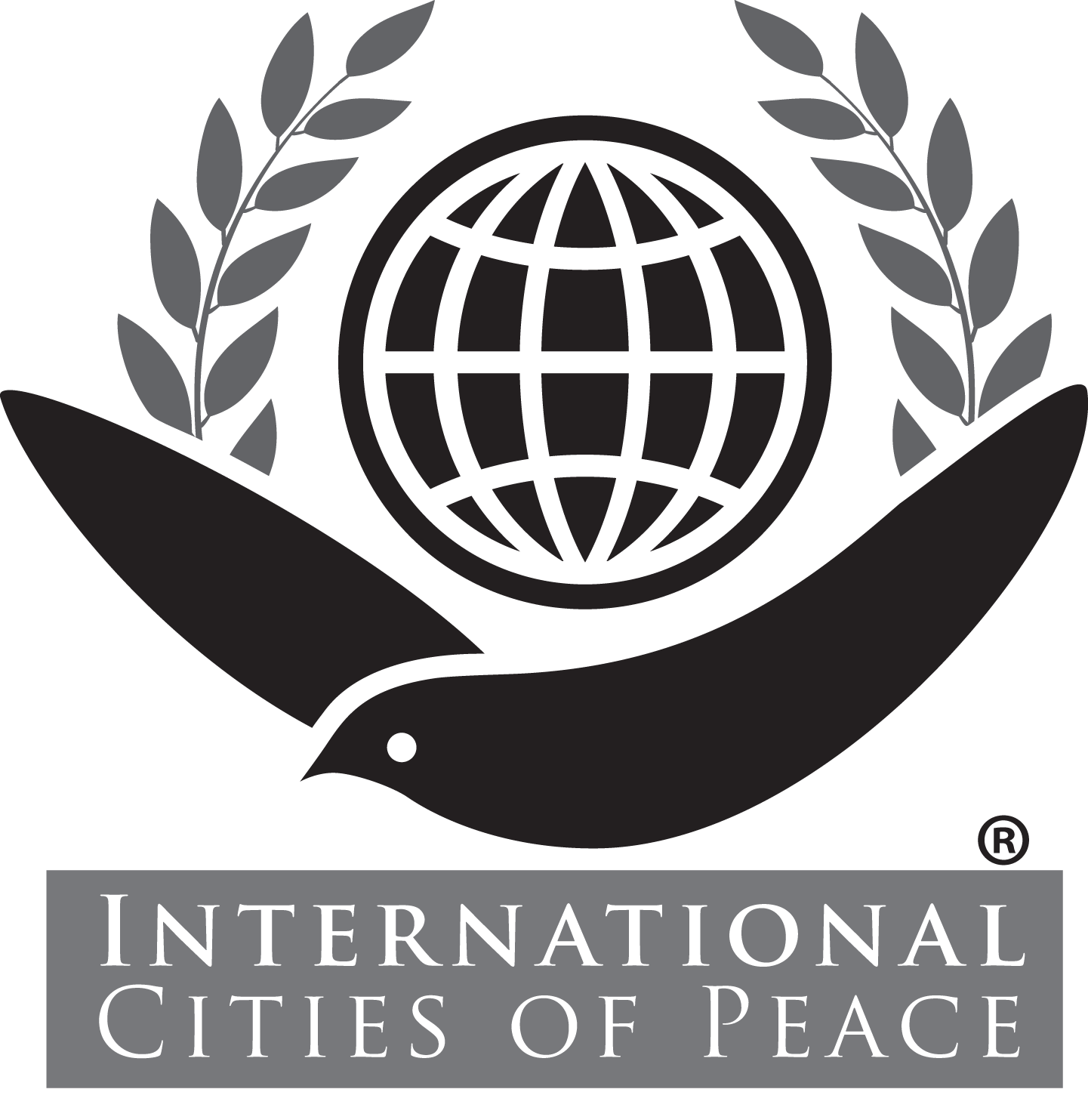Busan, Republic of South Korea: International City of Peace
We welcome BYEON Sung-wan, Acting Mayor, and the citizens and civic leadership of Busan Metropolitan City, which is established as an International City of Peace.
Busan served as the provisional capital of South Korea during the Korean war in 1950. It has grown to be the 2nd largest city in Korea. The United Nations memorial cemetery in Busan is the only memorial cemetery in the world where approximately 11,000 noble spirits of sacrificed UN forces rest in peace. It is also designated as a “Peace and Culture Zone for the United Nations”.

Busan has constantly strived to become an international peace city and develop projects to contribute to world peace. “Busan UN week” has taken place to celebrate the founding of the UN and pay tribute to Korean War veterans and to express gratitude. The events are hosted and organized by Busan city, BFIC and UN Memorial Cemetery. More details below.
Note: Introduction page with information primarily at the time of joining International Cities of Peace. For updates, please contact the liaison.

International Peace City, BUSAN!
Introduction
Busan, as the second-largest city in the Republic of Korea and a population of 3.51 million and the 6th largest port in the world, is a central city of maritime logistics in Northeast Asia and a gateway to the Eurasian continent. In addition, with the great achievement of successfully hosting the ASEAN-ROK Commemorative Summit twice, the city has become a hub for cooperation between ASEAN and the Republic of Korea.
• Population: 3.51millon (6.7% of national population)
• Land size: 770.04km2 (0.77% of Korean territory)
• Administrative structure: 16 districts/ boroughs
• Gross regional domestic product (GRDP): 81,263.5bil. (4.9% of national figure)
• Number of foreign tourists: 2,687,742 (2019)
• Industry structure: service (70.3%), manufacturing (19.8%), construction (5.9%),
agriculture & fisheries (0.8%), other (3.2%)

VISION
Busan, International Peace City in Northeast Asia

MISSION
International Peace City seeking peace & diversity with citizen
GOALS
1) Create flagship brand for realizing International Peace
2) Find out urban tasks for action to pursue UN Sustainable Development Goals and raise public awareness on them
3) Create a peaceful and inclusive atmosphere in which diverse cultures harmonize one another
4) Protect Cultural Properties related to the UN & Wartime Capital and enhance the historical value by an active publicity Busan, once a place with battle-scarred history and painful memory of the Korean War, has grown a city of hope and peace today while seeking permanent peace in the world.
Busan embraces one and only United Nations Memorial Cemetery in the world in which heroic brave soldiers from a number of UN nations who sacrificed their precious lives and dreams in Korean War to the cause of world peace are resting in peace.
The Busan city functioned a wartime provisional capital and politics, economy, national defense and diplomatic issues surrounding the Korea peninsula were dealt with in UNCOK(The UN Commission on Korea) located in Busan.
Busan city government have endeavoring to preserve cultural heritage which have the value of world peace. Furthermore, Busan city government has annually hosted the peace festival called ‘UN weeks’ to pay tribute to soldiers who fought and died during the Korean War to share the true meaning of peace they left us.


Korean War, UN, and History of Wartime Capital, Busan
Shortly after the breakout of the Korean War, the UN made the swift decision and recommendation to provide support to the Republic of Korea. 22 countries including the US, the UK, the Netherlands, France, New Zealand and Canada entered the Korean War and 41 more nations provided war supplies. A total of 1.95 million soldiers bravely fought to protect freedom in the Republic of Korea and 38,000 among them ultimately sacrificed their precious lives in a distant land far away from their own homelands. After the truce, the National Assembly made a resolution>resolve to designate the UN Memorial Cemetery in Busan as a sacred place and donated it to the UN permanently at no cost to honor the great sacrifice of the fallen peacekeepers in November of that year.
The UN accepted the decision and adopted the 977 resolution in the UN General Assembly which enabled the UN to manage the cemetery permanently.

After the Korean War outbreak, refugees from all around the nation flocked to Busan during 1,023 days during the war and built shacks(shack houses) along the mountain slopes to settle down and began to peddle everything they could in Busan International Market for survival even their sorrow from the loss of family and fear of war so deep. Still, there are some places where you can have a glimpse of the kind of life that refugees experienced. Finally, Busan became a peace city where the common people who did never lose their hope even amid the ruins of the Korean War and has steadily sought to be a city contributing common prosperity and peace in the international community.
Based on this historical background, Busan was declared as an international peace city in 2019. With the spirit of the UN, the city has implemented various projects, such as infrastructure projects, educational development and international exchanges to be an international peace city in Northeast Asia.
UN nations that participated in the Korean War
• 16 nations in combat: U.S.A, Canada, U.K, Turkey, Australia, Philippine, Netherlands, Thailand, Colombia, New Zealand, Greece, Ethiopia, Belgium, France, Republic of South Africa, and Luxemburg
• 6 in medical activities: Denmark, Germany, India, Italy, Norway, and Sweden

Local Event to foster International Peace City
1. Busan U.N. Weeks
The Busan city government has held a ceremony for ‘UN Day’ for the last 74 years to celebrate the establishment of the UN as well as to honor fallen UN heroes who sacrificed their precious lives in Korean War. Since 2019, the city government declared ‘International Peace City Busan’ and expand the ceremony into ‘Busan UN Weeks’ to raise public awareness.
During the event, Busan citizens in all walks of life from children, youth and entrepreneur to Korean war veterans pay tribute to the sacrificed war heroes. Also, the event offers a meaningful time for citizens to share genuine values of identity, history, infrastructure of a peace city, Busan, at the same time, it delivers the importance and significance of peace to citizens.

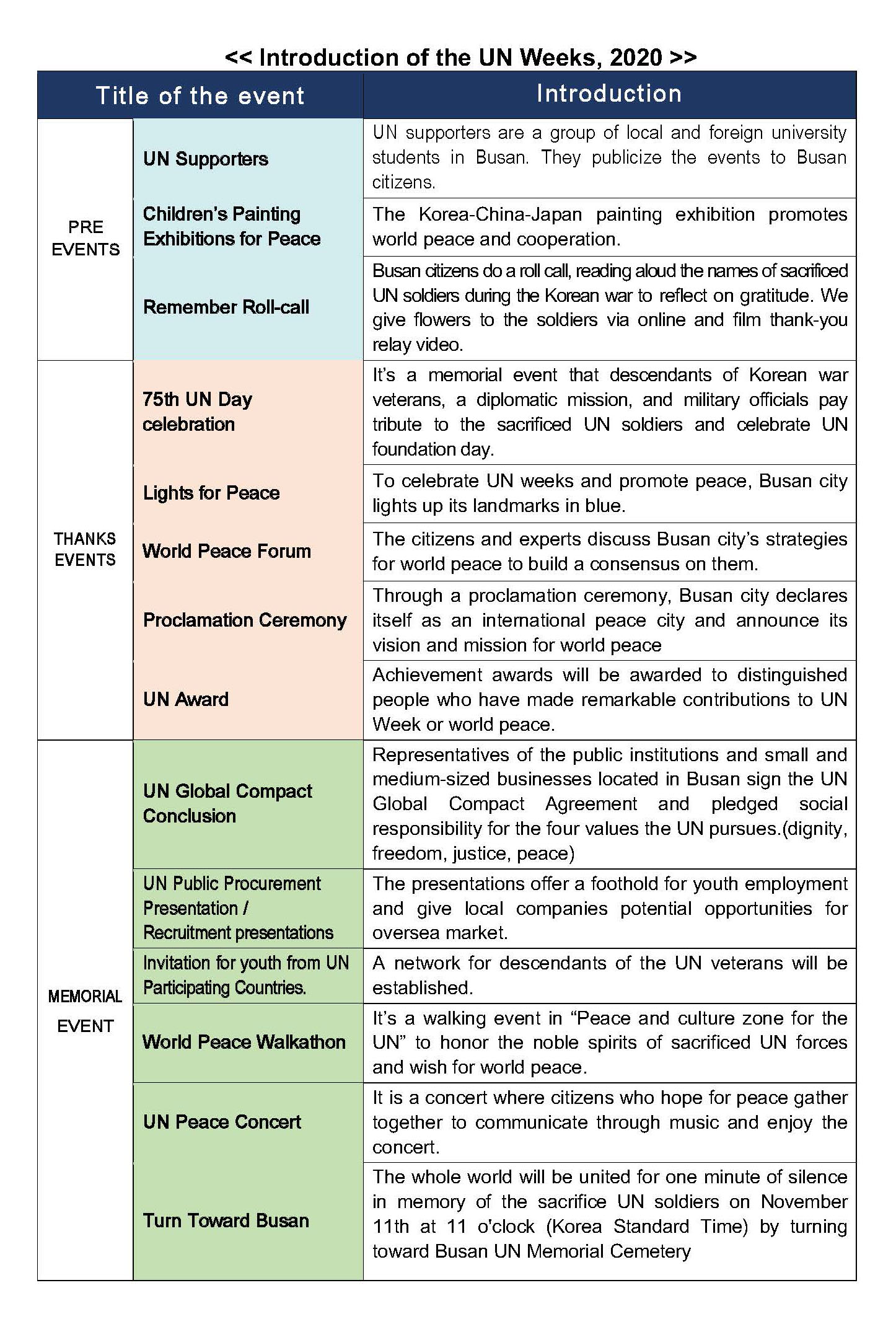
2. UN Peace and culture specialized zone
Busan has the first & only site designated as the UN peace and culture specialized zone. The city designated the 570,000-square-meter site near the UN Memorial Cemetery as a Special Peace and Culture Zone for the United Nations and it asked the UN for permission to officially use the organization’s name.
Upon approval, Busan has fostered the zone as worldwide sacred place in which it has actively implemented a variety of culture & tour projects on a large scale by creating United Nations Memorial Cemetery, UN Sculpture Park, Peace Park, United Nations Peace Memorial Hall, Culture Street in Dahak-ro, and National Memorial Museum of Forced Mobilization under Japanese Occupation.
3. Seek to Add UNESCO World Heritage Sites of ‘Korean War Heritage in Busan
Busan has actively sought to make the ‘Korean War Heritage in Busan’ to be listed on the World Heritage List of UNESCO in order to local architectural and cultural assets in 20th modern times and heighten its historical value.
As a result, the heritage made it onto a tentative lists of UNESCO world heritage sites, marking that the first time Korea’s 20th-centurty modern history has made it onto such a list. Busan is aiming to register the heritage to be listed on the UNESXO World Heritage list by 2025. The heritage is consisted of 8 heritage assets representing public and international cooperation.
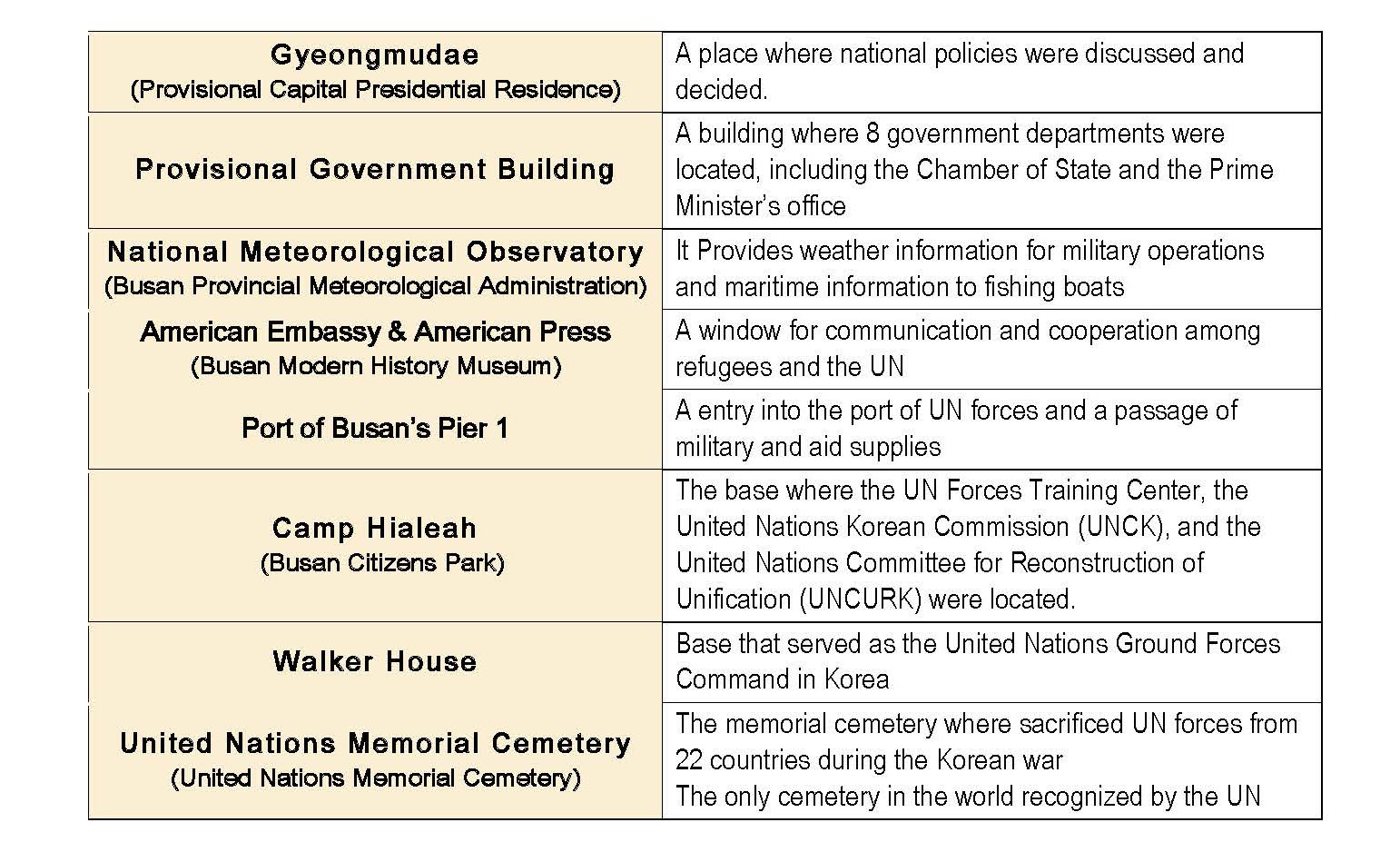
4. War-time Capital Busan Heritage Night
War-time Capital Busan Heritage Night is one of tour programs in Busan with a theme of history for citizens to experience heritages of war-time capital Busan firsthand. This program has been operated on annual basis to put a highlight on true values of Busan by developing contents of the history of Busan during Korean War while raise public awareness on them in order for listing the UNESCO World Heritage List of Korea’s cultural asset in modern times.
By giving more reality in the course of reconstruction in stories surrounding Korea War, this program offers various attractions and experiences for people to vividly feel the situation of the refugees faced and develop empathy for their stories during the 1950s, and have understanding on Korea’s cultural assets in modern times. At the same time, the program has been organized for people to have deeper understanding on the history and culture of Busan which has been transformed from a war-time capital into the peace city.
Busan UN Weeks, 2019 UN Peace and culture specialized zone War-time Capital Busan Heritage Night.

World Peace Forum 2020
- Slogan : “All Together as a City of Peace”
- Topic : Post-Covid-19 Era, SDGs and the Role of Local Government
- Date/Time : Thursday 29th October 13:30 – 17:20, 2020
- Venue : Grand Ballroom (1F), the Westin Chosun Busan
- Participants : Around 50 (VIPs, staff)
- Agenda : A keynote speech, declaration of accesion of ICP (International Cities of Peace), discussion sessions, announcement of action plans
- Method: Online and offline simultaneous interpretation(Kor·Eng) will be broadcast live
- Co-host: Busan Metropolitan City, Busan Foundation for International Cooperation
- Sponsor: KNN, BNK Busan Bank, Busan Ilbo, The Kookje Daily News
WEBSITES
• United nations memorial cemetery in Korea:
https://www.unmck.or.kr:450/eng/main/
• Busan metropolitan city:
http://english.busan.go.kr/index
• BFIC(Busan Foundation for International Cooperation):
http://www.bfic.kr/new/english/main/main.asp
• 2019 UN WEEK:
http://english.busan.go.kr/bsnews01/1407813
ABOUT THE LIAISON
BYEON Sung-wan is Acting Mayor of Busan Metropolitan City. He holds a B.A. in Administration from Korea University.
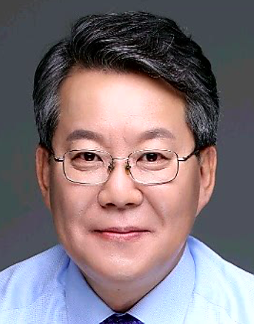
The following are his positions and awards:
Vice Mayor for Administrative Affairs, Busan Metropolitan City
Spokesperson of Ministry of the Interior and Safety (MOIS)
Director General for Regional Economy Support Bureau, MOIS
Assistant Mayor for Planning & Management, Busan Metropolitan City
Director General for Civil Safety T/F, MOIS
Director General for Policy Planning Bureau, MOIS
Director for Protocol and State Council Division, MOIS
Director for Local Accounting System Division, MOIS
Director for Local Subsidy Division, MOIS
Director for Local Tax Policy Division, MOIS
Director for Local Finance Policy Division, MOIS
Director for Local Administration Division, MOIS
Director for Local Legislation Division, MOIS
Korea Local Authorities Foundation for International Relations
Passed the 37th Higher Civil Service Examination
Award:
2015 Service Merit Medal (Red Stripes)
CONTACT INFORMATION
To contact or support this initiative:
Son Minji
Manager, Official Development Assistant Department
Telephone: 051.711.6865
Cultural Heritage of Peace city, Busan

1) United Nations Memorial Cemetery
Opened in 1951, the cemetery was established to honor the service and sacrifice of United Nations soldiers who died during the Korean War by the United Nations Command in 1951. It is the only officially recognized memorial cemetery by the UN, which honors approximately 11,000 of UN soldiers that served and died in battle during the Korean War from 1951 to 1954. However today, there are 2,300 graves on the site since most of the war heroes of US, Columbia, Ethiopia, Greece, Philippines, Thailand and remains of French and Norwegian heroes went back their home countries. The UN had been in charge of the management of the park but, it has been managed by Commission for the UNMCK consisted of 11 countries that have graves in the site since February 1974.
● Location 93, UN Pyeonghwa-ro, Nam-gu, Busan, 48529, Republic of Korea
● Remarkable Fact State-designated Registered Cultural Heritage No. 359
● Webpage http://www.unmck.or.kr



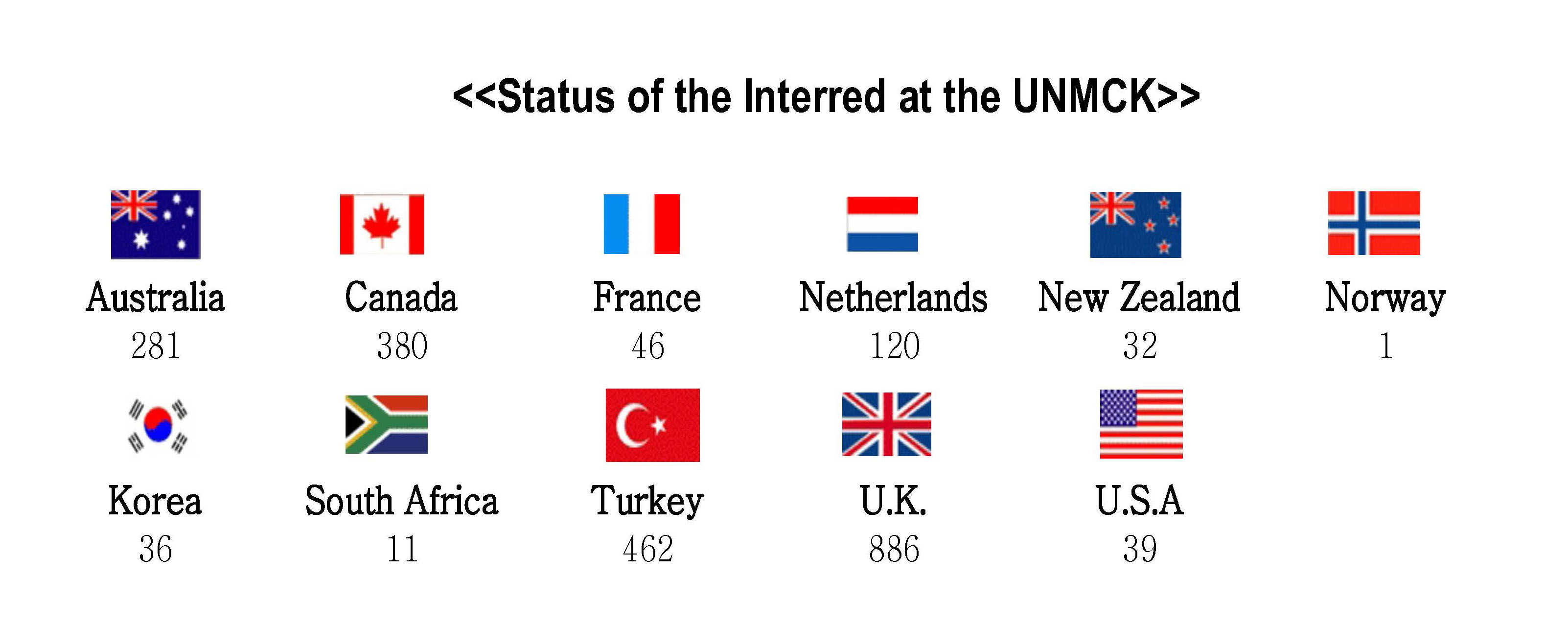 2) The UN Peace Memorial Hall
2) The UN Peace Memorial Hall
The UN Peace Memorial Hall was built to honor the noble spirit of the UN soldiers who made the ultimate sacrifice during the Korean War to protect freedom and peace in the Republic of Korea and to promote various projects related to world peace. We also focus on sharing and supporting all nations that wish for freedom and peace by inheriting and cherishing the UN veterans’ heroic spirit of sacrifice. The UN Peace Memorial Hall is an educational venue for passing on to our descendants who did not experience the reality of the war, the grave dangers of war and the armistice agreement. As such, we plan to carry out commemorative projects such as researching, hosting exhibitions, and publishing information honoring UN veterans. In addition, our memorial hall constantly strives to spread the shared goal of peace by becoming an important place for various activities, such as education and cultural events which strive to develop the courageous spirit of sacrifice and determination for the maintenance of peace.
● Location 106,Honggok-ro 320beon-gil, Nam-Gu, Busan, South Korea
● Exhibition The Korean War Exhibition Hall, The UN Allied Nations Memorial Hall, The UN International Peace Hal
● Webpage http://www.unmck.or.kr



3) UN Sculpture Park
To make the only UN Memorial Cemetery in the world that honors UN soldiers who died on their boots on during the Korean into a symbol of world peace and freedom, this park was officially established in October 2001 as a sacred symbol of peace and freedom. 34 sculptures have been created and donated by sculptors from the 21 nations that took part in the Korean War. The park is the result of the UN Memorial Cemetery International Sculpture Symposium which took place to commemorate the 50th anniversary of the start of the Korean War.
● Location 93, UN pyeonghwa-ro (Daeyeon-dong) , Nam-Gu, Busan, South Korea
● Remarkable Fact Korean War 50th Anniversary International Symposium lead to establish the park
● Dimension 15,458㎡ by UN Memorial Park


4) Provisional Capital Memorial Hall
The official residence of the president during the war was a two-story brick house located at the center of the complex, and was first built as an official residence for the governor of the province on August 10, 1926, when the provincial office of Gyeongsan Province was relocated to Busan from Jinju. When Busan served as the provisional capital of Korea (1950-1953), Korea’s first President Rhee Syngman stayed here. All final decisions on Korean politics were made in this place during the Korean War. The exhibit hall, a brick house with one basement and one above-ground floor, is a permanent exhibition hall displaying information on the outbreak of the Korean War and the lives of refugees, politics, economy, and culture in Busan during the provisional capital period.
● Location 93, UN Pyeonghwa-ro, Nam-gu, Busan, 48529, Republic of Korea
● Remarkable Fact State-designated Registered Cultural Heritage No. 359
● Webpage http://english.busan.go.kr/museum/.



5) Provisional Government Building
This building served as Gyeongsangnam-do Provincial Office during Japan’s colonial rule in 1925, The capital fled to Busan in 1950 because of the Korean War, the main building was used for government administration in which the nation reconstruction policies were decided such as refugee measures and financial aid. As one of representative modern time constructions, it has a distinct historical value embracing turbulent political and social change of the Republic of Korea in modern times. After alteration of its use several times, mostly used as local government office, the building was sold off to Dong-A University in 2002 and has served as the University Museum since 2009..
● Location 1, Bumin-dong 2(i)-ga (Registered Cultural Heritage No. 41)
● Webpage http://museum.donga.ac.kr/


6) Busan Modern History Museum(American Embassy & American Press)
Busan Modern History Hall, which was built in 1929 during the Japanese occupation period, was first used as the Busan branch of Dongyang-Cheocksik Ltd, also known as Oriental Colonization Company which was built as a colonial exploitation policy From 1949 after liberation, it became the Busan Culture Center of American Overseas Bureau of Public Information. As it was an icon of colonial invasion, it was made into the Busan Modern History Hall on July 3, 2003 to serve as an educational place to remind people of this tragic period of history. In the exhibition hall, visitors can see at a glance three-dimensional displays such as model structures, films & media and over 200 pieces of modern historical relics.
● Location 104, Daecheong-ro, Jung-gu, Busan, Republic of Korea

7) Ami-dong Tombstone Culture Village
The Tombstone Culture Village in Ami-dong(Ami village) was built on a place that was a former Japanese cemetery during Japanese colonial period. During the Korean war, a third of the Korean population flocked to Busan to avoid war, leading a lack of lands and materials for house construction. Therefore, the refugees began to settle down at higher up the mountains where used to be the Japanese cemetery. As you walk along narrow and maze-like alleyways in the village, you can encounter traces of refugees’ lives. Angular stone ornaments and gravestones that were utilized to build houses are placed. The village, the invaluable cultural heritage, has significant meaning as it still vividly portrays refugees’ hardship of life and desperateness for survival
● Location 49, Ami-ro, Seo-gu, Busan



Note: If information or photos used here are copyrighted, please contact us and we will immediately delete the copyrighted material.
